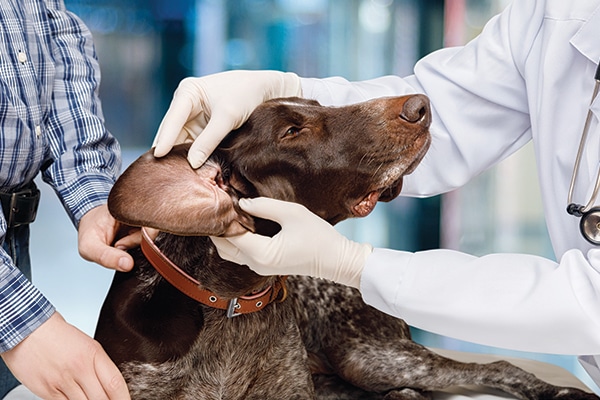Bosco was a cheerful Cocker Spaniel, quick with a lick and a wag. His mom, however, was not so cheerful and remarkably reluctant to smile. I was seeing Bosco for the first time, and his major issue was one many Cocker Spaniels face: chronic ear infections.
“All I want to know is how bad is his ear infection and can you cure it? I’ve been to four veterinarians over the past year and none of them have been successful. I’ll give you one chance, Dr. Ward,” she said.
“Well, I’ll do my very best to help Bosco. I know how much you care about him and I want to help him as much as …” Swifter than a cat strike, Mrs. Watkins sprung a hand in my face.
“Save me the pleasantries, doctor, and get to work.”
A common problem
Ear infections in dogs are one of the most common — and frustrating — conditions seen by veterinarians. Dog ears are particularly problematic because of:
- their conformation (the “L” shape that traps moisture and heat)
- skin allergies (don’t forget the ears are an extension of the skin)
- foreign debris that becomes stuck
- infections caused by bacteria, fungi and yeast.
Many dogs have a combination or most of these, making treatment a real challenge.
I carefully examined Bosco’s ear canals. Dogs with recurrent ear infections often have characteristic changes I describe as cobblestoning. Severe or chronic ear infections often cause the ear canal lining to become undulated with raised areas, similar to a cobblestone street. Bacteria and fungi are more likely to grow in these cracks and crevices, increasing the chances of reinfection. Other dogs will have long, tapering ear canals with a sharp bend or twist, preventing normal drying air flow, leading to high humidity. Some will have permanent scarring (or even holes) on their eardrum (tympanum). Bosco had all of these.

In active ear infections, I typically see a thick, mucous covering that has an offensive odor. I can smell Pseudomonas by its unique “grape” scent as soon as I lift an ear flap. The fungus Malassezia whiffs an undeniable “wet, muddy dog that rolled in a garbage dumpster” and nasty gram-negative bacteria stench reminds me of “worst morning breath ever.” Bosco’s ears reeked of spoiled grape juice.
I took culture samples from Bosco’s ears to send to the lab to find out what specific organisms were responsible for his infection and what medications would be effective against them. I also saved samples for me to stain and examine microscopically. My preliminary findings could give me a head start on treatment while we waited for the culture and sensitivity results.
As expected, I saw abundant bacterial organisms. What concerned me most was the presence of gram-negative rods, an early indicator that Bosco may have a more serious, and often antibiotic- resistant, Pseudomonas aeruginosa infection.
Treatment options
My plan was to thoroughly clean Bosco’s ears, disrupting and removing the bacterial biofilm, applying an antibiotic generally effective against Pseudomonas directly into the ear canal and prescribing an anti-inflammatory, antibiotic and home ear-cleaning regimen. Before cleaning the ears, I administered a mild anesthetic to ease any discomfort. After double-checking to make sure his eardrums were intact, I flushed the ear canals with warm, sterile water and coated them with an antibiotic solution. I sent him home with instructions to fill up each ear canal twice daily with an antibiotic mixed in a Tris-EDTA ear wash solution and a low dose of prednisolone to help reduce inflammation and pain. Bosco seemed more comfortable based on his increased tail wagging as he left my clinic, and I told Mrs. Watkins I’d call as soon as the lab results were complete.
The culture results arrived and indicated a highly drug-resistant strain of Pseudomonas was to blame. Luckily, the enrofloxacin I prescribed was one of the few antibiotics still effective. I updated Mrs. Watkins, and she reported that Bosco was better, but that “he was always better for a couple of days.” We scheduled a recheck in two weeks.
“I don’t know, and don’t care, what you did, but Bosco has been a different dog these past two-and-half weeks. Is he cured?”
That was a tough question. Most dogs with chronic ear infections require lifelong rechecks and ear cleaning. Many dog owners only seek veterinary help when things get out of control, leading to an infinite cycle of relapse-treatment- relapse. I recommended twice-monthly rechecks for the next three months, then monthly for another six. Periodically, we’d run bacterial cultures to identify any emerging infections before they became consequential.
“So, he’s not cured?”
“I’m afraid that’s a tall order for any dog suffering from a condition such as this. We can do our best to keep it …” Even over the phone, she could silence me.
“Keep it to yourself. As long as he feels this good, I’ll follow your advice. We’ll see you whenever you say.” And with that, a click. I gently hung up my phone, thrilled I made the most of my “one chance” with another pet patient.
Safe tips for clean ears
Keep an eye on your dog’s ears for any signs of infections. Regular cleaning needs only to be done if prescribed by your veterinarian, as over-cleaning can cause irritation and inflammation and even contribute to bacterial or fungal infections. If you do have to clean your dog’s ears, follow these tips:
- Use only veterinary-approved and recommended ear-cleaning solutions. Different ear cleaning products may alter the ear canal’s pH, increasing the likelihood of infections. Do not use a cotton swab or other devices inside your dog’s ears. You may inadvertently injure the lining or cause swelling.
- Warm the ear solution slightly by holding in your hands or pocket for a few minutes prior to instilling in the ear.
- Most veterinary ear-cleaning solutions are designed to kill bacteria, yeast or fungi and to loosen waxy debris. Do not forcefully irrigate or “squirt” the liquid; you could accidentally damage the eardrum. Instill until the ear canal is filled, and either gently wipe out the excess solution or your dog will shake the remaining liquid out of the ear canal. Most ear-cleaning solutions include a drying agent and do not require you to dry out the ear canal with a cloth or paper towel. Drying the ear canal can actually damage or irritate the sensitive tissue or push debris and infection deeper into the ear canal.
- Do not use homemade solutions, especially vinegar-and-water solutions. Unless you carefully balance the solution pH, you could damage the ear canal or worsen an existing infection.








